
The alphorn or alpenhorn or alpine horn is a labrophone, consisting of a straight several-meter-long wooden natural horn of conical bore, with a wooden cup-shaped mouthpiece. Traditionally the Alphorn was made of one single piece, or two parts at most, of the wood of a red pine tree. Sometimes the trees would bend from the weight of snow in winter, and this caused them to have the larger and bent mouthpiece at their ends. Modern Alphorns are sometimes made from three distinct parts that can be attached together: this is to make them easier to transport by car, or even to carry them by hand, and today they are more frequently made from the wood of a spruce tree or fir tree. The alphorn is used by mountain dwellers in the Swiss Alps. Similar wooden horns were used for communication in most mountainous regions of Europe, from the Alps to the Carpathians. Alphorns are today used as musical instruments.
The clarinet is a single-reed musical instrument in the woodwind family, with a nearly cylindrical bore and a flared bell.
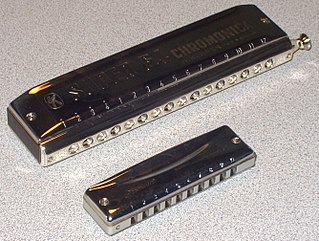
The harmonica, also known as a French harp or mouth organ, is a free reed wind instrument used worldwide in many musical genres, notably in blues, American folk music, classical music, jazz, country, and rock. The many types of harmonica include diatonic, chromatic, tremolo, octave, orchestral, and bass versions. A harmonica is played by using the mouth to direct air into or out of one holes along a mouthpiece. Behind each hole is a chamber containing at least one reed. The most common is the diatonic Richter-tuned with ten air passages and twenty reeds, often called the blues harp. A harmonica reed is a flat, elongated spring typically made of brass, stainless steel, or bronze, which is secured at one end over a slot that serves as an airway. When the free end is made to vibrate by the player's air, it alternately blocks and unblocks the airway to produce sound.
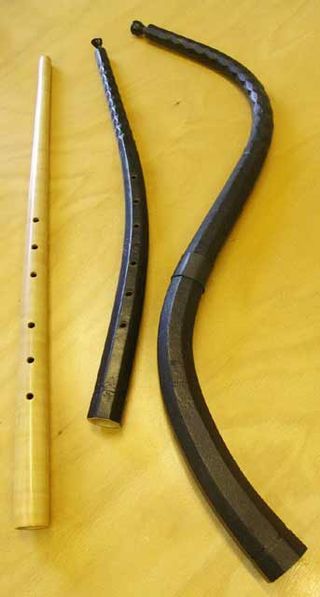
The cornett, cornetto, or zink is a wind instrument that dates from the Medieval, Renaissance and Baroque periods, popular from 1500 to 1650.

A lur, also lure or lurr, is a long natural blowing horn without finger holes that is played with a brass-type embouchure. Lurs can be straight or curved in various shapes. The purpose of the curves was to make long instruments easier to carry and to avoid directing the loud noise at nearby people.

The ney, is an end-blown flute that figures prominently in Egyptian Music, Persian music, Turkish music, Jewish music and Arabic music. In some of these musical traditions, it is the only wind instrument used. The ney has been played continually for 4,500–5,000 years, dating back to ancient Egypt, making it one of the oldest musical instruments still in use.

The tenor saxophone is a medium-sized member of the saxophone family, a group of instruments invented by Adolphe Sax in the 1840s. The tenor and the alto are the two most commonly used saxophones. The tenor is pitched in the key of B♭ (while the alto is pitched in the key of E♭), and written as a transposing instrument in the treble clef, sounding an octave and a major second lower than the written pitch. Modern tenor saxophones which have a high F♯ key have a range from A♭2 to E5 (concert) and are therefore pitched one octave below the soprano saxophone. People who play the tenor saxophone are known as "tenor saxophonists", "tenor sax players", or "saxophonists".

Twente is a region in the eastern Netherlands. It encompasses the most urbanised and easternmost part of the province of Overijssel. Twente is most likely named after the Tuihanti or Tvihanti, a Germanic tribe that settled in the area and was mentioned by the Roman historian Tacitus. The region's borders are defined by the Overijssel region of Salland in the northwest and west, the German County of Bentheim in the northeast and east and the Gelderland region of the Achterhoek in the south.
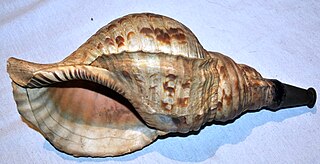
Horagai are large conch shells, usually from Charonia tritonis, that have been used as trumpets in Japan for many centuries. The instrument, which has served a number of purposes throughout Japanese history, has been given a number of Japanese names depending on its function. Special schools still teach students to play the traditional music associated with the conch.

A friction drum is a musical instrument found in various forms in Africa, Asia, Europe and South America. In Europe it emerged in the 16th century and was associated with specific religious and ceremonial occasions.
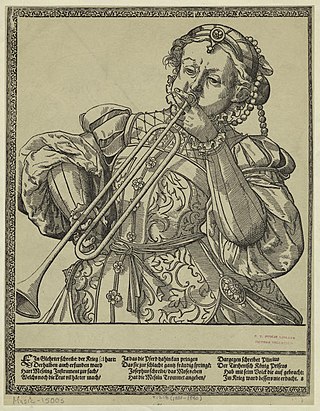
Clarion is a name for a high-pitched trumpet used in the Middle Ages and the Renaissance. It is also a name for a 4' organ reed stop that produces a high-pitched or clarion-like sound on a pipe organ in the clarion trumpet's range of notes.
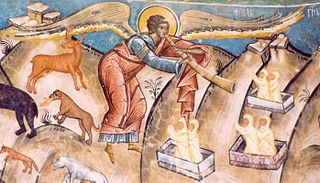
The bucium is a type of alphorn from Romania and Moldova. The word is derived from Latin bucinum, originally meaning "curved horn", an instrument used by the Romans. The word is a cognate with English "bugle".

The mouthpiece of a woodwind instrument is that part of the instrument which is placed partly in the player's mouth. Single-reed instruments, capped double-reed instruments, and fipple flutes have mouthpieces while exposed double-reed instruments and open flutes do not. The characteristics of a mouthpiece and reed can play a significant role on the sound of the instrument.
The chromatic trumpet of Western tradition is a fairly recent invention, but primitive trumpets of one form or another have been in existence for millennia; some of the predecessors of the modern instrument are now known to date back to the Neolithic era. The earliest of these primordial trumpets were adapted from animal horns and sea shells, and were common throughout Europe, Africa, India and, to a lesser extent, the Middle East. Primitive trumpets eventually found their way to most parts of the globe, though even today indigenous varieties are quite rare in the Americas, the Far East and South-East Asia. Some species of primitive trumpets can still be found in remote places, where they have remained largely untouched by the passage of time.

The birch trumpet is a type of natural trumpet made of spruce covered with birch bark, known in Norway, Sweden, Finland, England, Denmark, Latvia, Lithuania, Belarus and Estonia. Even cruder and less durable versions were made of plain birch bark. They are associated with the early European Chalet culture, where it was presumably used to intimidate predators, frighten supernatural enemies, and convene council meetings.

Christmas is celebrated throughout December and traditionally until St. Knut's Day on January 13. The main celebration and the exchange of gifts in many families takes place on Christmas Eve, December 24. The Feast of St. Lucy, a high point in the Swedish Christmas season, is celebrated during Advent, on December 13.

A horn is any of a family of musical instruments made of a tube, usually made of metal and often curved in various ways, with one narrow end into which the musician blows, and a wide end from which sound emerges. In horns, unlike some other brass instruments such as the trumpet, the bore gradually increases in width through most of its length—that is to say, it is conical rather than cylindrical. In jazz and popular-music contexts, the word may be used loosely to refer to any wind instrument, and a section of brass or woodwind instruments, or a mixture of the two, is called a horn section in these contexts.

Nafir, also nfīr, plural anfār, Turkish nefir, is a slender shrill-sounding straight natural trumpet with a cylindrical tube and a conical metal bell, producing one or two notes. It was used as a military signaling instrument and as a ceremonial instrument in countries shaped by Islamic culture in North Africa, the Middle East and South Asia. In Ottoman, Persian and Mugulin miniatures, the nafīr is depicted in battle scenes. In Christian culture, it displaced or was played alongside of the curved tuba or horn, as seen in artwork of about the 14th century A.D.
















